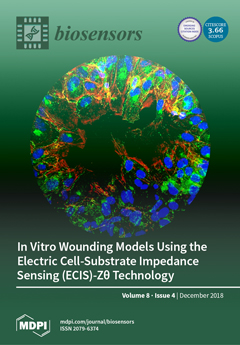Open AccessArticle
Magnetic Nanoparticle-Based Biosensing Assay Quantitatively Enhances Acid-Fast Bacilli Count in Paucibacillary Pulmonary Tuberculosis
by
Cristina Gordillo-Marroquín, Anaximandro Gómez-Velasco, Héctor J. Sánchez-Pérez, Kasey Pryg, John Shinners, Nathan Murray, Sergio G. Muñoz-Jiménez, Allied Bencomo-Alerm, Adriana Gómez-Bustamante, Letisia Jonapá-Gómez, Natán Enríquez-Ríos, Miguel Martín, Natalia Romero-Sandoval and Evangelyn C. Alocilja
Cited by 14 | Viewed by 9099
Abstract
A new method using a magnetic nanoparticle-based colorimetric biosensing assay (NCBA) was compared with sputum smear microscopy (SSM) for the detection of pulmonary tuberculosis (PTB) in sputum samples. Studies were made to compare the NCBA against SSM using sputum samples collected from PTB
[...] Read more.
A new method using a magnetic nanoparticle-based colorimetric biosensing assay (NCBA) was compared with sputum smear microscopy (SSM) for the detection of pulmonary tuberculosis (PTB) in sputum samples. Studies were made to compare the NCBA against SSM using sputum samples collected from PTB patients prior to receiving treatment. Experiments were also conducted to determine the appropriate concentration of glycan-functionalized magnetic nanoparticles (GMNP) used in the NCBA and to evaluate the optimal digestion/decontamination solution to increase the extraction, concentration and detection of acid-fast bacilli (AFB). The optimized NCBA consisted of a 1:1 mixture of 0.4% NaOH and 4% N-acetyl-L-cysteine (NALC) to homogenize the sputum sample. Additionally, 10 mg/mL of GMNP was added to isolate and concentrate the AFB. All TB positive sputum samples were identified with an increased AFB count of 47% compared to SSM, demonstrating GMNP’s ability to extract and concentrate AFB. Results showed that NCBA increased AFB count compared to SSM, improving the grade from “1+” (in SSM) to “2+”. Extending the finding to paucibacillary cases, there is the likelihood of a “scant” grade to become “1+”. The assay uses a simple magnet and only costs $0.10/test. NCBA has great potential application in TB control programs.
Full article
►▼
Show Figures






